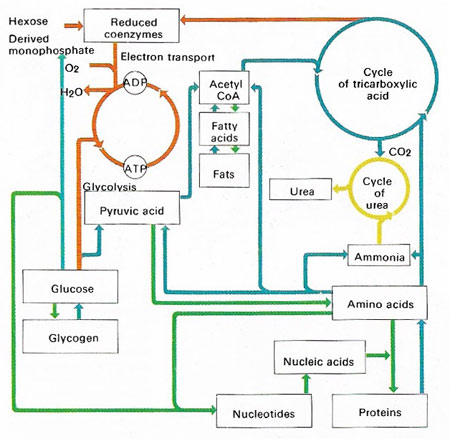metabolism

Every cell is the site of a complex series of chemical reactions that includes both synthesis (anabolism) and breakdown (catabolism). These processes are known collectively as metabolism. Pathways that are basically catabolic are shown in blue, those basically anabolic in green. Paths directly concerned with energy production and use in brown. Many thousands of separate chemical reactions are involved, each controlled by a different enzyme. Overall balance and control is ultimately maintained by the genetic material of the cell, which governs the production of enzymes.
Metabolism is the combination of biochemical processes by which energy, obtained from an external source, is harnessed to maintain internal order and a state of chemical disequilibrium. It includes all of the chemosynthetic (anabolic, anabolism) and degradative (catabolic, see catabolism) reactions that take place in living organisms. The ability to metabolize is generally considered to be one of the fundamental characteristics of life (see life, nature).
Metabolic reactions are catalyzed by enzymes in a highly integrated and finely controlled manner so that there is no overproduction or underutilization of the energy required to maintain life. All energy required to maintain life is ultimately derived from sunlight by photosynthesis, and most organisms use the products of photosynthesis either directly or indirectly. The energy is stored in most living organisms in a specific chemical compound, adenosine triphosphate (ATP). ATP can transfer its energy to other molecules by a loss of phosphate, later regaining phosphate from catabolic reactions.
Electron transport system
An electron transport system, also known as an electron transport chain, is a sequence of biochemical reactions that transfers electrons, through a series of carriers, in certain metabolic processes. It involves carrier substances that accept electrons and then donate them to the next carrier in the chain, while themselves undergoing a series of redox reactions. It forms the last stage of aerobic respiration in cells, causing hydrogen atoms to combine with oxygen to form water and conserving energy in the form of ATP. Photosynthesis also involves an electron transport system.


